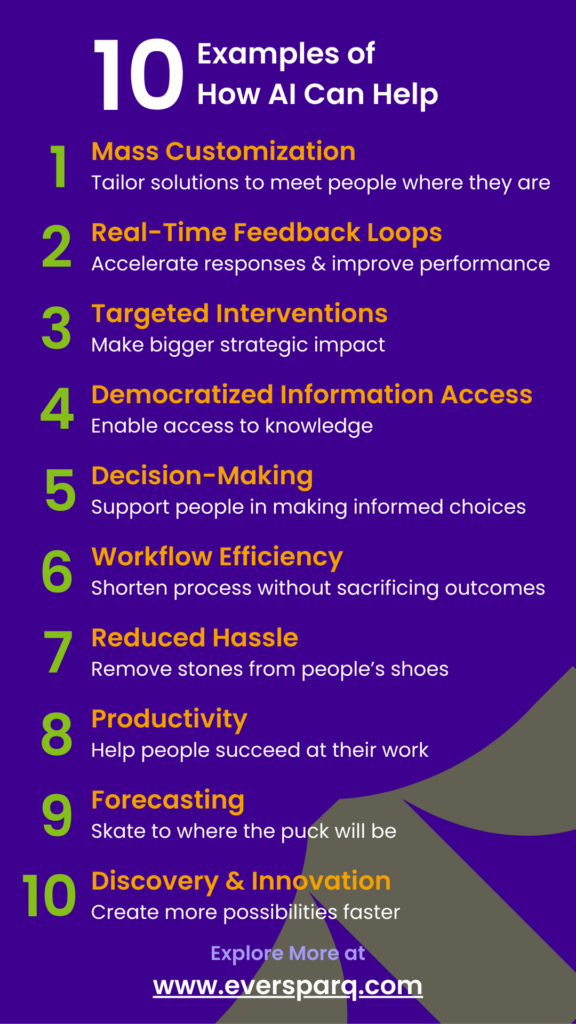
Figuring out how AI can support your company strategy
Ever wonder how AI can help you and your business and how to get started? With artificial intelligence (AI) front and center in so many conversations, it can be overwhelming to process what it is and how it can be applied. Making the leap from AI concepts to real-life, practical applications that help solve challenges for your day-to-day business is not always intuitive.
I like the following two grounding questions posed by Chris Childs, Director of Product Management at Snowflake. I think they succinctly get to the heart of how machine learning can help:
“What questions do you wish you could ask but can’t because you don’t have all the data? What questions are you answering today but it takes a long time?”
With these questions in mind, here are some common themes I’ve come across for when AI might be a good tool to support your business’ success. Although by no means comprehensive, these examples are intended to spark ideas and inform decisions about how to responsibly make decisions about what AI investments are the best for your company.
10 High Impact Examples of When AI Can Help
- Mass Customization
Meeting people where they are and appealing to their unique circumstances, needs, and wants can be extremely challenging and cost-prohibitive at scale. AI can help sift through massive amounts of data to engage people in ways in which they feel seen and to tailor experiences to their individual needs.
Examples: outreach/communication campaigns with curated content, providing relevant resources, appointment reminders, employee engagement activities - Real-Time Feedback Loops
Rather than waiting for annual or delayed periodic data dumps for assessing performance, risk exposure, or progress, AI can help gather and synthesize comprehensive, real-time data to anticipate key risks and enable timely course correction. This can dramatically compress the performance improvement fly wheel and accelerate results.
Examples: performance feedback, employee engagement, corporate compliance planning, fraud detection - Targeted Interventions
Identifying primary stakeholders with whom to focus your limited time and energy for greatest impact can enhance return on investment of resources. By ingesting broad swathes of data, machine learning can illuminate trends and patterns of who to focus on and how.
Examples: population health management, market share and revenue growth, employee engagement, identifying burnout and reducing high-risk turnover, creating stickiness with existing customers, clinical trial recruitment/eligibility - Democratizing Access to Information
With the exponential expansion of data and content generation, it can be easy to drown in information overload. Machine learning tools can be designed to assist with curation of and access to the right information and format best-suited to diverse learning styles.
Examples: chat interfaces, interactive access to company information and content curation for employees, self-service tools - Better Decision-Making
There are any number of decisions we make or that are made about us every day that can involve time-consuming research. With the aid of user prompts, AI can provide meaningful decision support by filtering out background noise to quickly predict and match individual needs with right-fit options.
Examples: home loan approvals, screening candidates, choosing among different health insurance options - Creating Efficient Workflows
AI can help reduce standard workflow steps such as highly time-intensive manual data management into relatively real-time, automated access to information. Eliminating non-valued-added steps on the customer journey from identifying customer needs through resolution can go a long way in improving workforce satisfaction and customer experience.
Examples: equipment monitoring and maintenance, appointment scheduling, task prioritization, supply chain optimization - Reducing Hassle
Much of what erodes employee and customer engagement is the amount of non-value-added effort that may be involved with completing a task. AI can help eliminate these stones in people’s shoes, freeing up time for them to achieve their full potential.
Examples: electronic mail inbox management, natural language processing to transcribe written content into audio or podcast formats that can be listened to on the go, synthesizing discussions into written summaries - Workforce Productivity
As companies are faced with doing more with fewer resources, optimizing daily work is imperative. Rather than displacing humans, AI can help augment their ability to be more impactful and successful at doing their work while practicing at the top of their license or training. AI has also been shown to help accelerate the learning curve of newer employees and make expensive and labor-intensive activities much more affordable and faster.
Examples: ambient listening to capture and format unstructured data, enabling professionals to practice at the top of their license or training, real-time access to solutions for new customer support workers to resolve customer complaints in the moment - Forecasting
Predictive analytics powered by machine learning can help humans anticipate certain events or trends and then take steps to plan accordingly. This can focus resourcing decisions, reduce waste, and accelerate achievement of strategic goals.
Examples: energy consumption forecasting, disaster planning, investment planning - Discovery & Innovation
Machine learning can process and combine data inputs into a near-infinite number of scenarios in relatively brief periods of time that would otherwise take a lifetime of manual human effort. It can also process immense amounts of data to reveal previously unrecognized patterns and correlations that can enable faster identification of more effective interventions and problem-solving.
Examples: new drug identification through recombinant innovation, evaluation of medication toxicity risks, public health monitoring & outbreak detection, market segmentation, product research & development
“What questions do you wish you could ask but can’t because you don’t have all the data? What questions are you answering today but it takes a long time?”
Conclusion
Whether you’re still at the initial exploration phase of where to start your AI journey or you already have AI projects in flight, here are a couple of things to think about:
- How do your AI projects align with your strategy? AI efforts should support the successful execution of your strategic priorities rather than introducing distraction and potentially diluting focus and resources.
- How diverse is your AI portfolio? If you’re just getting started, consider a limited number of quick-win AI solutions to demonstrate return on investment and to engage end users in getting used to interacting with AI. Rather than progressing from easier, near-term and harder, longer-term AI projects in a linear sequential manner, concurrently initiating a heavier lift, longer-term solution or two, while you are developing AI muscle with simpler projects can compress the timeline to competitively be leveraging game-changing AI tools in the future.
Incorporating AI into your business strategy can be an exciting journey of discovery! Let’s explore the right approach for your company, together. Contact info@eversparq.com or visit www.eversparq.com to start the conversation.


About Christopher Kodama
Dr. Kodama’s 25+ years of executive and clinical leadership encompasses guiding strategy design and implementations for start-ups and new programs, managing IT implementations, and leading cost structure improvement initiatives and turnarounds…
